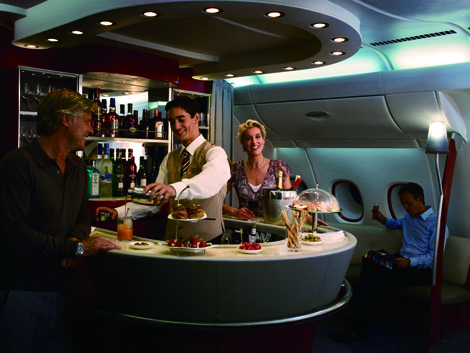Size counts in the aviation industry, but so does efficiency and environmental concerns – and on all fronts the gigantic Airbus A380 comes up trumps, writes Alisha Haridasani
Today, the idea of the Airbus A380 – the superjumbo, the Big Bird, the Giant of the Skies – is commonplace. But before it was launched in 2007, a large-scale double-decker aircraft was to most people little more than an improbable concept.
If you think about it, such a plane is a phenomenal notion to grasp: an aircraft almost twice as long as a blue whale and heavier than 100 elephants, with the capacity to seat up to 853 passengers, making the Boeing B747 – the previous biggest aircraft – look like Thumbelina. And that’s just the size factor; also of great note is the incredible fuel efficiency – 20 per cent less fuel burn per seat than the B747 – and the customisable interiors that offer carriers a world of options, from bars to showers as well as wider seats.
The idea of this behemoth aircraft first came about in the early 1990s. “We knew we had a potential in the market place for a successor to the B747,” explained Richard Carcaillet, Airbus’s director of marketing for the A380, who has been involved in the project since its inception.
“Our forecasts showed us that air traffic would grow by 4 to 5 per cent every year despite the occasional hiccups in the world economy or geopolitics. So, on high volume routes, there was no way an airline could keep growing and meeting demand without a bigger aircraft.”
In fact, the product was so obviously needed that at some point between concept development and making the aircraft a reality, Airbus and its biggest competitor, Boeing, actually pondered working together on this superjumbo. However, with Boeing having the upper hand at the time, it became evident that a collaboration would not be to Airbus’s advantage.
“The interests of the series of discussions were very much in Boeing’s favour because they could continue selling 747s while keeping us at discussion stage,” said Carcaillet.
In 1996, Airbus created its own Large Aircraft Division to focus on pushing the idea beyond the drawing board. The group worked closely with 20 of the top airlines in the world to understand the industry’s needs. “They didn’t want an aircraft that is better just because it is bigger,” said Carcaillet. “They wanted cost reduction, fuel efficiency and a smaller environmental footprint by notably reducing the noise of the aircraft.”
After four years, production began when the Airbus board decided that there were a sufficient number of pre-emptive orders – 60 to be precise – to really spend the big bucks and build the airplane. “That’s when we launched detailed design efforts in parallel to setting up new assembly facilities that had to be designed for the aircraft, given its size.”
Manufacturing is spread across different plants in various countries, based on the aircraft section. Wings, for example, are made in the UK. A total of six section-specific facilities were built to handle the manufacturing, including the final assembly line in Toulouse, France and the painting facility in Hamburg, Germany. In the latter two facilities alone, a total of nearly 2,000 employees work on putting the aircraft together, installing the cabin and painting the livery.
In October 2007, Singapore Airlines flew the first A380 and since then the plane has been a great success. Within just four years, a combined total of 57 A380s are in operation by seven carriers – Singapore Airlines, Qantas, Emirates, Lufthansa, Air France, Korean Air and, most recently, China Southern. Each carrier has its own unique setup and flies to various major hubs, including London, Hong Kong, Frankfurt and Sydney (see pages 70 and 71 for more details).
Over the next few years, more carriers will take delivery of the A380, including Malaysia Airlines (MAS), Thai Airways, British Airways, Air Austral, Virgin Atlantic and Qatar Airways, all of which will also offer their own unique features.
The stakes were high when Airbus launched this project, but it is now evident that they have yielded a runaway success. In the near future, with more airlines set to deploy A380s across their network, the plane may become more common but by no means any less fantastic. The B747 has been an icon in aviation development for many decades, but for some time to come, it seems, the A380 will be the king of the sky.
To see what our readers think of the plane and to join the lively discussion on the A380, click here.
To download the published pages for this story, click here. Adobe Reader required.

The technical side
Greater comfort is achieved with more space and fresher cabin air. The main deck cabin is 20 inches wider than the B747 and, in turn, all seats are up to 1.5 inches wider. The aircraft’s air conditioning and ventilation system changes the air every three minutes for better circulation.
Greater fuel efficiency is achieved by using double the proportion of light weight composite material compared to previous aircraft such as the A340. This, in combination with new aerodynamics and engine designs, makes the aircraft 15 metric tonnes lighter than it would be if made completely of metal.
Noise reduction The A380 makes half the noise of the B747 during take off because the engines are larger in diameter, enabling more cold air to pass through them.








